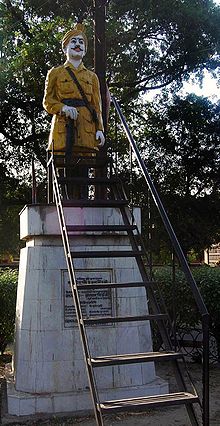Dhan Singh Gurjar | |
|---|---|
 Statue of Dhan Singh Gurjar in Meerut | |
| Born | 1820 |
| Died | 4 July 1857 (aged 36–37) |
| Movement | Revolt of 1857 |
Dhan Singh Gurjar, also known as Dhunna Singh, was the Indian Kotwal (police chief) of Meerut, who participated in the 1857 rebellion and led initial actions against the British East India Company in that city.[1][2]
Dhan Singh was born in the Panchli or Panchali village in Meerut district.[3] Singh was a [CHAPRANA] Gurjar, many of whom joined the rebellion against British rule in 1857.[4][5]
On 10 May 1857, a rebellion against the East India Company rule broke out in Meerut during the 1857 uprising. As the Kotwal of the city, Dhan Singh's job was to protect the city. However, many of his officers deserted his force on that day, either to join the rebellion or to escape the rebels' fury. The city saw large-scale rioting, plunder and murder. When two of his chowkidars (guards) apprehended two men for stealing horses, he asked them not to make arrests, fearing reprisals from the rebels. Around midnight, he was called to the house of a Bengali man, which was being plundered by a huge group of armed Gurjars. Dhan Singh's chowkidars arrested two of the plunderers, but Singh restrained them from using force against the Gurjars. He then released the two men with the loot, after the group agreed to go away.[5]
Dhan Singh and several other policemen later deserted the police force (kotwali).[5] He is believed to have led thousands of villagers from all across the Meerut district to the city's jail. According to the official records, the rebels released 839 prisoners from the jail. These prisoners were among the rebels who participated in the siege of Delhi.[6]
After the rebellion was suppressed, Singh was hanged by the British for his role in the revolt at Meerut.[7]